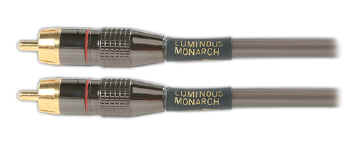|
You are reading the older HTML site Positive Feedback ISSUE 10october/november 2003
luminous audio Monarch II Signature interconnects as reviewed by Carlo Flores
|
||
|
|
My reference interconnects are Tara Labs' Air 3 and Master Generation 2, and a pair of Cardas Neutral Reference, which cost more than the Luminous Audio Technology Monarch II Signatures at $149 per meter. I feel somewhat silly for investing so much into wire and termination, though my cables fit my system perfectly. The Cardas Neutral Reference imparts a slight and roundness to brass and female vocals that I find appealing, and I like the Tara Labs cables because they're smooth in the midrange and easy on top, never hard or bright. I'm not sure there is "neutrality" in hi-fi, and I wouldn't call my cables neutral. They are flavored, but unlike many other cables, they give me the details of the source. The Luminous Audio Technology Monarchs don't have personality, but they aren’t ultra-revealing either. I received two pairs of the broken-in Luminous Audio Technology interconnects, and during the first two weeks they were used in headphone rigs, either with the electrostatic Stax Omega II/717 (the most revealing commercial headphone system I've heard to date—see next issue for a review), or my reference dynamic headphones. The cables are rather simple in appearance. The connectors don't lock, and the jacket is slightly reflective. The flexibility of the cable is excellent, better than my reference cables. Luminous Audio Technology claims that their products are bullshit-free, and they give details on their website. Surprisingly,
considering their price, the Monarchs are balanced in sound. Jimmy Smith on Root Down did not sound as sharp, clear, or stark
as he could, but the veil was only slightly evident. The cymbal work didn't shimmer, and
lacked the subtlety given it by my reference cables. There wasn't the full, yet fast
midbass, or the grain on But, consider the competition. Tara Labs' RSC Axiom ($129/m) and DH Labs' Air Matrix ($200/m) both err toward smoothness, a trait I prefer to harshness (as with DH Labs Silver Sonic). Balance without accentuation is simply better. The Kimber Kable Hero isn't quite as lacking in emphasis as the Luminous Audio Technology, and guitar plucks and fret slides are clearer with the Monarchs. Kimber PJB is a very good cable for the money, especially with syrupy-sounding equipment, but sounds thin and sharp compared to the Monarchs. The detail retrieval of the Luminous Audio Technology is better than its competition, and while the DH Labs Air Matrix was a cable I loved because it fit my bias, the Luminous Audio Technology don't have such an obvious sound. Add to this the Luminous Audio Technologys’ disregard for associated components—its sound is consistent regardless of the component attached—and they make a strong case for themselves as the best cable at their price point. Using the cables in my speaker setup, from my CD player into a DACt CT-2 Stepped Attenuator—a passive preamp that can reveal much of a cable's character—to my Conrad-Johnson SA-250 amplifier, yielded excellent tonal balance. I accept errors of omission, and I reached a point, immediately after switching back to either of my reference cables, of missing the Luminous Audio Technology Monarchs. I find I must measure what the cables do right against what they do wrong. For example, the Cardas Neutral Reference only has that glow and roundness of line on certain instruments—other times it is revealing, if not ruthless. The Tara Labs Master Generation 2 is smooth and soft, but there is so much information that the lack of sharp leading lines or flat high frequency response are apparent. There is certainly more information present than with the Luminous Audio Technology, and while neither cable has that pseudo-detail brightness thing going on, are they tonally correct? With the Luminous Audio Technology, there aren't these characteristics. The top end doesn't stand out from the midrange, female vocals don't catch the ear, midbass isn't recessed. Using them throughout my system lead to acceptance. I just set them in place and forgot about them. Only when compared to other, much more expensive cables did the lack of inner detail stand out. Tom Waits' "Martha," from Closing Time, is an example of this. With the Monarchs, the piano washed out behind Waits' voice, and the violin during the hook blended, smeared, and faded into the background. The Luminous Audio Technology Monarch II Signatures are recommended, highly, for those unwilling to spend a couple of C-notes (or more) on a pair of interconnects, and aren't looking for flavor. I am interested—very—in what Luminous Audio Technology's reference interconnects and speaker cables have to offer. Carlo Flores
|
|
Monarch
II Signature interconnects Luminous Audio Technology
|


 the horns, that I get normally. Nevertheless, and I find this significant, I
didn't lose the music. When the Luminous Audio Technology was directly compared to my
reference cables, information faded into the background. Take the organic beats of Mos
Def's Black on Both Sides, which didn't
completely show up, but had impact. This album has foot-tapping polyrhythms, but there's
also layered information that staggers the ear. There was just a little too much blend and
bloom with the Luminous Audio Technology, not due to a thick or exaggerated presentation,
but a lack of full interpretation. Something distinct—that half beat's immediacy, the leading line on
percussion—was gone.
the horns, that I get normally. Nevertheless, and I find this significant, I
didn't lose the music. When the Luminous Audio Technology was directly compared to my
reference cables, information faded into the background. Take the organic beats of Mos
Def's Black on Both Sides, which didn't
completely show up, but had impact. This album has foot-tapping polyrhythms, but there's
also layered information that staggers the ear. There was just a little too much blend and
bloom with the Luminous Audio Technology, not due to a thick or exaggerated presentation,
but a lack of full interpretation. Something distinct—that half beat's immediacy, the leading line on
percussion—was gone.